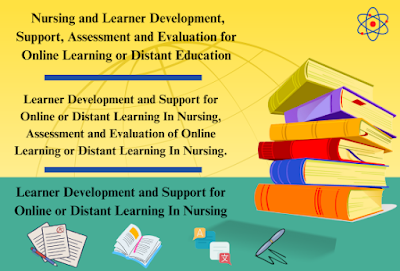The Learner Development Support Assessment and Evaluation for Online Learning or Distant Education In Nursing. In nursing education, assessment methods can be broadly divided into formative and summative assessments: Formative assessments: These are ongoing assessments that provide students with continuous feedback and help them improve their skills and understanding over time.
The Learner Development Support Assessment and Evaluation for Online Learning or Distant Education In Nursing
In online or distance nursing education, learning support, assessment, and evaluation are crucial for effective learning. Assessments help students understand their progress and areas for improvement, while evaluations provide a more complete picture of learning outcomes and inform teaching practice. Learning support focuses on creating a supportive learning environment and providing resources that help students succeed.
Assessment is important in all areas of nursing education and practice to gain insight into student learning, evaluate competencies and clinical performance, and inform further decisions about students and nurses. Assessments are an essential component of monitoring the quality of education and healthcare programs.
Introduction to Online Education in Nursing
Introducing online education into nursing programs can significantly impact the delivery of learner support services. This effect is particularly pronounced when online education influences more than just a few individual courses. The institution’s student support services must be reassessed and adapted to effectively support both geographically distant students and those on campus (Mills, Fisher, & Stair, 2001; Nelson, 2007).
National and Accreditation Requirements
National higher education accrediting bodies, as well as nursing accrediting organizations, mandate that academic support services for online students should be comparable to those available for on-campus students (Baldwin & Burns, 2004). Essential support services needing reconsideration for online learners include academic advising, tutoring, financial aid, library, and bookstore services.
Accessibility and Restructuring
Ensuring accessibility for students with disabilities is crucial. Additionally, the admission and registration processes may need restructuring to accommodate students who cannot be physically present on campus. Financial decisions regarding tuition, student technology, and distance education fees must also be addressed. Universities and colleges typically charge on-campus fees like activity and parking fees—these may need to be adjusted or waived for online students.
Faculty Support and Guidance
Faculty play a critical role in guiding students new to online learning. These learners often need initial assistance in managing their time effectively. Online education requires students to take responsibility for their learning in ways they may not be accustomed to, moving from a structured classroom to a more independent learning environment (Johnston, 2008).
Managing Expectations and Participation
Students might mistakenly believe that online courses are easier than traditional ones, only to find themselves overwhelmed by the need for self-direction. Faculty can mitigate this by clearly defining participation expectations and assignment due dates (Beitz & Snarponis, 2006; Zsohar & Smith, 2008). Weekly online discussions should be included in the syllabus, and inactive students should be reached out to during the first few weeks to address possible technology issues or challenges with self-directed learning (Halstead & Coudret, 2000).
Orientation and Technology Support
An effective orientation to the Course Management System (CMS) and other required technologies is essential. Carruth, Broussard, Waldmeier, Gauthier, and Mixon (2010) developed a 5-day online orientation course that significantly improved technology proficiency among graduate students, reducing attrition. Institutions should provide similar technology orientation and support for distant learners.
Building Institutional Relationships
Students in online programs also need orientation to the institution, school, and program to foster a sense of presence and belonging. Effective use of websites, social networking, and virtual campus tours can help establish connections and create a strong institutional relationship. The “Facebook effect” can enhance social networking, increase engagement, and stimulate intellectual discourse (Hurt et al., 2012).
Assessment and Evaluation of Online Learning or Distance Learning in Nursing
Importance of Assessment and Evaluation
Faculty and administrators must consider how to assess and evaluate online courses and programs to ensure curriculum and program outcomes are met and to support continuous quality improvement (Billings, 2000).
Methods of Measuring Effectiveness
The effectiveness of online courses can be evaluated using various methods, including quality indicators, benchmarks, and accreditation standards. Quality Matters (QM) provides a national benchmark for online course design, with standards covering course overview, learning analytics, assessment, instructional materials, course activities, technology, learner support, and accessibility (Quality Matters [QM], 2014).
Quality Matters Standards
The QM rubric includes the following standards:
- Course overview and introduction
- Learning analytics
- Assessment and measurement
- Instructional materials
- Course activities and learner interaction
- Course technology
- Learner support
- Accessibility and usability
Continuous Quality Improvement
A systematic evaluation plan is essential for fostering continuous quality improvement. This plan should address institutional support, faculty satisfaction, student satisfaction, technology adequacy, and effectiveness in meeting learner outcomes. Data on student enrollment, academic progression, and graduation rates can inform retention strategies. Additionally, rubrics for faculty and peer review of online courses can aid in maintaining high standards (Broome, Halstead, Pesut, Rawl, & Boland, 2011; Hunter & Krantz, 2010; Blood-Siegfried et al., 2008).
Learner Development Support Assessment and Evaluation for Online Learning or Distant Education In Nursing
Read More:
https://nurseseducator.com/didactic-and-dialectic-teaching-rationale-for-team-based-learning/
https://nurseseducator.com/high-fidelity-simulation-use-in-nursing-education/
First NCLEX Exam Center In Pakistan From Lahore (Mall of Lahore) to the Global Nursing
Categories of Journals: W, X, Y and Z Category Journal In Nursing Education
AI in Healthcare Content Creation: A Double-Edged Sword and Scary
Social Links:
https://www.facebook.com/nurseseducator/
https://www.instagram.com/nurseseducator/
https://www.pinterest.com/NursesEducator/
https://www.linkedin.com/in/nurseseducator/
https://www.researchgate.net/profile/Afza-Lal-Din
https://scholar.google.com/citations?hl=en&user=F0XY9vQAAAAJ

Наиболее свежие новости подиума.
Важные мероприятия самых влиятельных подуимов.
Модные дома, бренды, высокая мода.
Лучшее место для стильныех хайпбистов.
https://enovosibirsk.ru/news/2023-11-24-zaderzhan-zamestitel-direktora-departamenta-gosudarstvennoy-politiki-i-regulirovaniya-v-sfere-razvitiya-osobo-ohranyaemyh-prirodnyh-territoriy/
https://novosibirsk.rftimes.ru/news/2024-03-01-pozharnye-spasli-rebenka-iz-goryashchey-kvartiry
https://enovosibirsk.ru/read/2024-01-27-remont-dorog-i-ban-v-novosibirske-novosti-i-rekonstruktsiya-muzeya-kondratyuka/
https://kursktoday.ru/news/2024-01-28-ugmk-stal-11-kratnym-obladatelem-kubka-rossii-po-basketbolu
https://kursktoday.ru/news/2024-01-28-ugmk-stal-11-kratnym-obladatelem-kubka-rossii-po-basketbolu